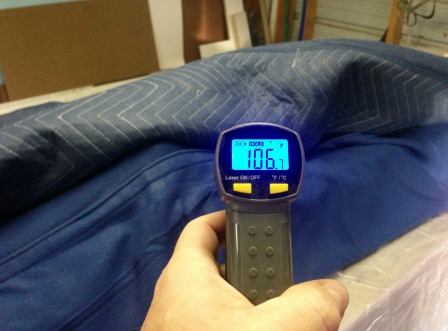Countertops Magazine Archive
Considerations for Making Concrete Countertops in Cold Weather
When the temperature begins to drop, it is important to know that casting of concrete countertops can be negatively affected. To minimize issues, it’s critical to keep your concrete (not necessarily yourself) comfortable.
Many of the problems encountered by concrete countertop fabricators can be alleviated using accelerated curing methods involving heat, this is especially crucial in the colder months of the year. These problems include:
• Curling – caused by one side of the slab losing moisture faster than the other side of the slab. Density is directly related to strength, the denser the concrete at stripping, the lower the moisture loss potential.
• Cracking – higher strength at stripping means there is less potential for cracking.
• Drying Shrinkage/Crazing – the higher the percentage of Portland that is hydrated prior to stripping, the lower the volume of free water available to evaporate and cause shrinkage.
• Pop outs while grinding or pieces that won’t take a polish – the higher the PSI, the better the sand grains (or glass) will be held in place and shaved off rather than pulled out.
• Sealing – the less free water contained in the capillaries of your concrete, the better most sealers will perform.
-
Keeping your concrete warm, not necessarily your shop, is the important thing in cold temperature settings. photo courtesy of Mitch Costilow, Costilow, Pearidge Concrete, Grenada, Miss.
Heating and Curing in Cold Temperatures
There are several ways to use heat in the batching and curing process that can help to minimize problems caused by cold ambient temperatures.
• Use hot water in your mix if required – keep your batch temperatures above 60 degrees F at a minimum. This will give your concrete a head start. It takes a lot of time and energy to get concrete from 50 to 60 degrees, where the heat of hydration will start to help things along. Warmer concrete means less bugholes, and using hot water equals less entrained air.
• The concrete must not be allowed to lose moisture during heat curing or you may be creating more problems than you are solving, so make sure to cover it with plastic sheathing to keep water from evaporating off the surface.
• A simple way to apply heat to your concrete is to cover your pieces (already covered in plastic) with a standard-type electric blanket that you might find at a department store and then an insulating blanket. This adds heat to the curing process and maintains the heat of hydration, or temperature at which the concrete cures. The chemical reaction process that takes place when concrete turns from a liquid state to a solid one is an exothermic reaction that consequently gives off heat. You want to retain this heat for as long as possible to produce strong, dense concrete. This process will help to do that. If your budget allows, you may want to consider using a Power Blanket (www.powerblanket.com).
• Concrete strength gain vs. temperature is non linear. Once you cross the threshold of 130 degrees you can actually gain 500+ PSI per hour; heat to 180 degrees and you’re in the 1,000 PSI per hour strength gain area. However, I don’t recommend heating countertops above 140 degrees or so as the moisture loss potential or a runaway temperature gain (boil the water out) could ruin your concrete.
• If you were to cast tops today, cover them with plastic and cure at 70 degrees for seven days, then cast another set and heat cure them for one day, the strengths would be roughly equal.
All said, if you follow this advice, you don’t have to worry about your shop temperature. As long as your concrete is kept warm and happy, turn your shop heat down at night and save a few bucks.
With a little planning, casting concrete countertops in cold weather can be pain-free, for your concrete at least.
About the Author
To find out more about Trinic concrete processes or admixes go to www.trinic.us or contact author Mark Celebuski at [email protected] or a (800) 475-1975.
|

